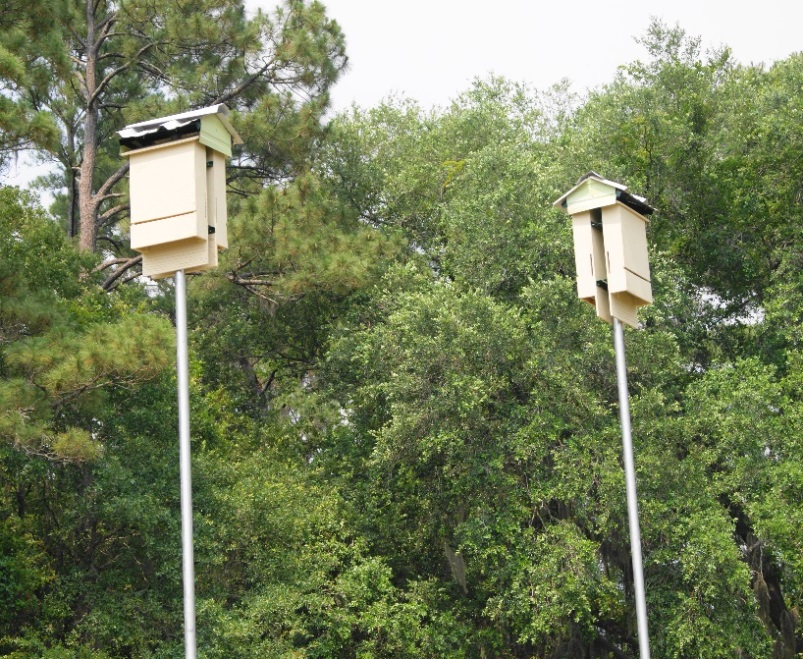
Bats, like this Seminole bat (Lasiurus seminolus), are economically beneficial. They consume many insect pests without the use of pesticides. Photo Credit: Kathleen Smith, Florida Fish & Wildlife Conservation Commission
Holly Ober, UF/IFAS Wildlife Ecology & Conservation Specialist
Eleven different species of bats live in north Florida year-round. These bats are voracious feeders. During spring, females with young can eat nearly their entire body weight each night. Their food of choice: a wide variety of night-flying insects, many of which are the adult stages of agricultural pests.
The Brazilian free-tailed bat (Tadarida brasiliensis), the evening bat (Nycticeus humeralis), the big brown bat (Eptesicus fuscus), and the southeastern bat (Myotis austroriparius) are known to consume some of the most destructive pests to corn, cotton, pecans, and people. These include
- corn earworm (Helicoverpa zea)
- fall armyworm (Spodoptera frugiperda)
- cabbage looper (Trichoplusia ni)
- tobacco budworm (Heliothis virescens)
- pecan nut casebearer (Acrobasis nuxvorella)
- hickory shuckworm (Cydria caryana)
- green stinkbugs Chinavia halaris
- mosquitoes
To obtain free pest control services from bats, protect the sites where the bats roost (sleep) during the day. Hollows inside live and dead trees, spaces beneath bark on the boles of dead or dying trees, palm fronds, clumps of Spanish moss, rock crevices, and caves are natural structures used by sleeping bats. Simply maintaining all trees with cavities and peeling bark, refraining from pruning dead palm fronds, and not disturbing Spanish moss is a start to locally encouraging bats. Also, some bats are also drawn to man-made structures such as bridges, culverts, mines, buildings, and bat houses.
If you want to proactively lure bats to your land, consider putting up some bat houses. All four of the bat species most likely to consume insect pests in our region typically prefer to roost in man-made structures such as bridges, attics, stadiums, picnic shelters, barrel tile roofs, and bat houses. This is great news because small bat houses are easy to build and the materials required are fairly inexpensive.
Also, pre-made bat houses can be purchased at many gardening stores or online. But beware that many pre-made houses will not attract bats because of poor design or construction. Below are the characteristics that distinguish good bat houses from the rest:
- Roost chambers should be a minimum of 20 inches tall
- Roost chambers should be at least 14 inches wide
- Roost partitions should be spaced 3/4 inches apart (1 inch is appropriate in South Florida)
- A 3- to 6-inch landing pad should extend below the entrance to facilitate movement of bats in and out of the house
- Interior surfaces and landing areas should be rough to provide footholds for bats
- Sharp objects such as screws, staples, nails, and mounting hardware should not protrude into the roost chambers
- ½ inch tall ventilation slots should be provided no more than 1/3 the distance from the bottom
- Chemically-treated and pressure-treated wood should not be used. Boards of cedar or pine are appropriate. Plywood should be exterior grade (e.g. ACX, T1-11, BCX)
- All exterior joints should be caulked or sealed to prevent drafts or leaks
The Bat Conservation International website (www.batcon.org) lists specific vendors in each state who sell bat houses with these characteristics known to be preferred by bats.
Careful consideration then needs to be given to the location where you put the bat house up. Bat houses are most likely to be occupied when mounted on a post or the side of a building: not on a tree. When mounted in a location exposed to sunlight all day, houses should be painted a light color so that some heat from the sun is reflected. When mounted in a location that receives little sunlight, a medium brown works well so that some heat from the sun is absorbed.
Sources of additional information:
Insect Pest Management Services Provided by Bats
Effective Bat Houses for Florida
- May 2025 Weather Summary and Summer Outlook - June 20, 2025
- Friday Feature:The History of Angus Cattle - June 20, 2025
- Friday Feature:High Quality Legume Hay Production – Virtual Tour of Conrad Farms - June 6, 2025

